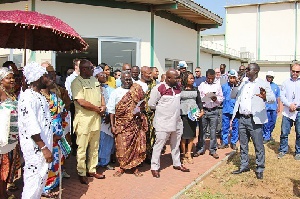 Cargill Ghana Plant Manager, Smart Darkwah, explaining how the installation works
Cargill Ghana Plant Manager, Smart Darkwah, explaining how the installation works
Stakeholders in the energy industry in Ghana on Monday November 27, got their first viewing of the new Cargill state-of the-art solar facility which was commissioned by President Nana Addo Dankwa Akufo-Addo on November 8, 2017.
This energy project contributes to Cargill’s global strategy to enhancing sustainable food processing and entrenching environmentally friendly, renewable ways of generating power for industrial production. The project also contributes to Cargill’s sustainability goals; safety and sustainable ways of bringing down energy cost.
The fully automated, digital PV solar system designed, supplied and installed by Dutch & Company (Gh) Ltd., will produce 764MWh of electricity annually to augment energy needs at the Tema Factory. It will also boost Ghana’s vision of achieving 10% contribution of renewable energy in electricity generation mix by 2020.
The energy produced at the plant is equivalent to powering nearly 400 homes with electricity for a year for every year the plant is operational.
Guest of honour at the inauguration event, Deputy Minister for Trade and Industry, Hon. Carlos Kingsley Ahenkorah, speaking on behalf of government said, “the government is committed to increasing the nation’s renewably energy generation capacity to help confront the challenges in the power sector and we are hopeful that others in the Ghanaian cocoa industry will follow Cargill’s lead.”
Commenting on the objective for the installation of the solar plant, Pieter Reichert, Managing Director for Cargill Cocoa & Chocolate in Ghana said the initiative is part of Cargill’s sustainability plan which seeks to find innovative, environmentally friendly ways of doing business globally.
“We believe it is our responsibility to find ways to continuously decrease the environmental impact of our businesses. Cargill sets ambitious new targets every five years to reduce greenhouse gas intensity, improve energy efficiency and increase renewables as a part of our portfolio. One of our goals is to increase renewables to 18 percent of our energy portfolio. Today, 14 percent of our energy needs are met by renewables, and this solar project will contribute further to the realization of the global goal”.” explained Mr. Reichert.
“We were honoured the President commissioned this project. It speaks volumes of the government’s commitment to support the private sector and especially those of us in the cocoa industry. The project represents our (both government and private sector) collective effort at enhancing industrial production in the cocoa sector through sustainable, energy-efficient means” Mr. Reichert concluded.
The Deputy Director for Clean Energy at the Ministry of Energy, Dr. Robert Sogbabji speaking on behalf of his Ministry, congratulated Cargill and expressed his delight at Cargill’s initiatives in renewable energy which he says aligns with his Ministry’s plan on Clean Energy.
On his part, the U.S. Ambassador to Ghana, H.E. Robert P. Jackson added that the move to solar generated energy is commendable since it forms part of the global strategy to reduce carbon emission and make the environment safe. He called for both local and international partnerships within the renewable energy sub-sector in order to raise Ghana’s installed generational capacity.
In attendance at the event were representatives from the Enclave Power Company (EPC), the Ghana Free Zones Authority, VRA, Solidaridad, and EPA among others.
About the Installation
EPC Contractors of the project, Dutch & Co.(Gh.) Ltd, a company that specializes in energy efficiency through LED lighting and PV Solar installations, say the installation capacity is divided over an open field ground mount system of 413KWp and a Car Port system of 152KWp. In total, 2,136 solar panels were used, each with a capacity of 265Wp.
To install the ground mount structure, a specialized Pile Driver was used to provide the supporting structure for the panels. This is a technique used often for large-scale solar installations.
The installation’s peak power generation period is between 11am and 3pm, during which period 15% of Tema’s electricity needs will be supplied by the solar panels.